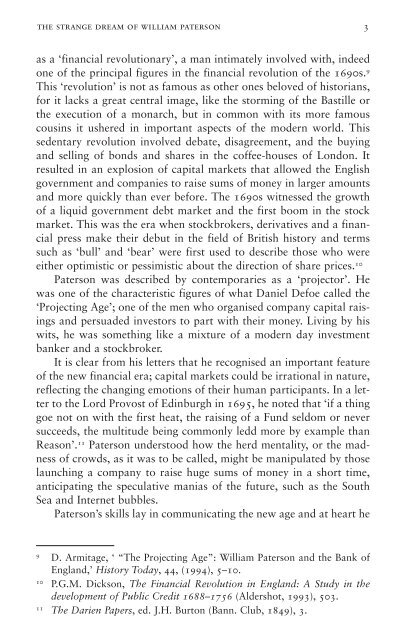Create successful ePaper yourself
Turn your PDF publications into a flip-book with our unique Google optimized e-Paper software.
<strong>Price</strong> <strong>of</strong> <strong>Scotland</strong> B format_Layout 1 03/11/2020 11:09 Page 3<br />
the strange dream <strong>of</strong> william paterson 3<br />
as a ‘financial revolutionary’, a man intimately involved with, indeed<br />
one <strong>of</strong> the principal figures in the financial revolution <strong>of</strong> the 1690s. 9<br />
This ‘revolution’ is not as famous as other ones beloved <strong>of</strong> historians,<br />
for it lacks a great central image, like the storming <strong>of</strong> the Bastille or<br />
the execution <strong>of</strong> a monarch, but in common with its more famous<br />
cousins it ushered in important aspects <strong>of</strong> the modern world. This<br />
sedentary revolution involved debate, disagreement, and the buying<br />
and selling <strong>of</strong> bonds and shares in the c<strong>of</strong>fee-houses <strong>of</strong> London. It<br />
resulted in an explosion <strong>of</strong> capital markets that allowed the English<br />
government and companies to raise sums <strong>of</strong> money in larger amounts<br />
and more quickly than ever before. <strong>The</strong> 1690s witnessed the growth<br />
<strong>of</strong> a liquid government debt market and the first boom in the stock<br />
market. This was the era when stockbrokers, derivatives and a financial<br />
press make their debut in the field <strong>of</strong> British history and terms<br />
such as ‘bull’ and ‘bear’ were first used to describe those who were<br />
either optimistic or pessimistic about the direction <strong>of</strong> share prices. 10<br />
Paterson was described <strong>by</strong> contemporaries as a ‘projector’. He<br />
was one <strong>of</strong> the characteristic figures <strong>of</strong> what Daniel Defoe called the<br />
‘Projecting Age’; one <strong>of</strong> the men who organised company capital raisings<br />
and persuaded investors to part with their money. Living <strong>by</strong> his<br />
wits, he was something like a mixture <strong>of</strong> a modern day investment<br />
banker and a stockbroker.<br />
It is clear from his letters that he recognised an important feature<br />
<strong>of</strong> the new financial era; capital markets could be irrational in nature,<br />
reflecting the changing emotions <strong>of</strong> their human participants. In a letter<br />
to the Lord Provost <strong>of</strong> Edinburgh in 1695, he noted that ‘if a thing<br />
goe not on with the first heat, the raising <strong>of</strong> a Fund seldom or never<br />
succeeds, the multitude being commonly ledd more <strong>by</strong> example than<br />
Reason’. 11 Paterson understood how the herd mentality, or the madness<br />
<strong>of</strong> crowds, as it was to be called, might be manipulated <strong>by</strong> those<br />
launching a company to raise huge sums <strong>of</strong> money in a short time,<br />
anticipating the speculative manias <strong>of</strong> the future, such as the South<br />
Sea and Internet bubbles.<br />
Paterson’s skills lay in communicating the new age and at heart he<br />
9<br />
D. Armitage, ‘ “<strong>The</strong> Projecting Age”: William Paterson and the Bank <strong>of</strong><br />
England,’ History Today, 44, (1994), 5–10.<br />
10<br />
P.G.M. Dickson, <strong>The</strong> Financial Revolution in England: A Study in the<br />
development <strong>of</strong> Public Credit 1688–1756 (Aldershot, 1993), 503.<br />
11<br />
<strong>The</strong> Darien Papers, ed. J.H. Burton (Bann. Club, 1849), 3.


















